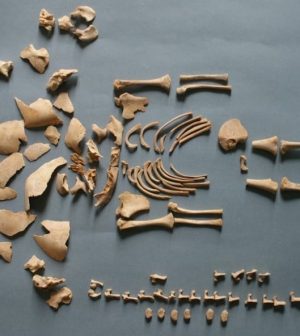- Understanding the Connection Between Anxiety and Depression
- How Daily Prunes Can Influence Cholesterol and Inflammation
- When to Take B12 for Better Absorption and Energy
- Epsom Salts: Health Benefits and Uses
- See What Saffron Can Do for Sleep and Heart Health
- 6 Common Mistakes to Avoid Before Your Physical
- Can Sweating Really Help You Beat a Cold?
- Strengthening Your Relationship: Practical Strategies
- Skip Storing This Everyday Product in the Fridge Door
- Green Tea + B3 Pairing May Boost Brain Health
Remains Show Prehistoric Peoples Cared for Those With Down Syndrome

Rare gene-driven defects such as Down syndrome have occurred among human beings for many thousands of years, a new analysis of ancient DNA has revealed.
Not only did the birth defects exist, but these infants were often buried with care by their community. That suggests they were included as part of the community despite their differences, researchers said.
Six cases of Down syndrome and one case of Edward syndrome (a more severe condition) have been found in the surviving DNA of human populations living in Spain, Bulgaria, Finland and Greece as long as 4,500 years ago, researchers said.
These results came from DNA analysis of about 10,000 ancient humans looking for autosomal trisomies, a birth defect in which people carry an extra copy of one of the first 22 chromosomes.
All of the cases were detected in infant burials, but from different cultures and time periods, researchers said.
“Using a new statistical model, we screened the DNA extracted from human remains from the Mesolithic, Neolithic, Bronze and Iron Ages all the way up to the mid-1800s,” said lead researcher Adam Rohrlach, a statistician from the University of Adelaide’s School of Mathematical Sciences in Australia.
Down syndrome occurs when a person is born with an extra copy of chromosome 21. It is associated with developmental delays, mild to moderate intellectual disability, and a characteristic set of facial features, according to the U.S. Centers for Disease Control and Prevention.
“While we expected that people with Down syndrome certainly existed in the past, this is the first time we’ve been able to reliably detect cases in ancient remains, as they can’t be confidently diagnosed by looking at the skeletal remains alone,” Rohrlach said in a university news release.
The statistical model used for the new analysis identifies when a person has about 50% too much DNA coming from one specific chromosome, researchers said.
“We then compared the remains of the individuals with Down syndrome for common skeletal abnormalities such as irregular bone growth, or porosity of the skull bones, which may help to identify future cases of Down syndrome when ancient DNA can’t be recovered,” said researcher Patxuka de-Miguel-Ibáñez of the University of Alicante in Spain.
The study also uncovered a case of Edwards syndrome, an even rarer condition caused by three copies of chromosome 18.
This genetic defect causes far more severe symptoms than Down syndrome, researchers said. The remains showed signs of severe abnormalities in bone growth, and the child died around 40 weeks gestation.
All of these infants were buried with care, showing that ancient societies understood they were part of their community despite their birth defects, researchers said.
This was particularly true of the Early Iron Age in Spain, where researchers found the single case of Edwards syndrome and an increased number of cases of Down syndrome.
The new study was published Feb. 20 in the journal Nature Communications.
“The remains could not confirm that these babies survived to birth, but they were among the infants buried within homes at the settlement, or within other important buildings,” said researcher Roberto Risch, an archaeologist from The Autonomous University of Barcelona.
“We don’t know why this happened, as most people were cremated during this time, but it appears as if they were purposefully choosing these infants for special burials,” Risch continued.
More information
The National Institutes of Health has more about Edwards syndrome.
SOURCE: University of Adelaide, news release, Feb. 20, 2024
Source: HealthDay
Copyright © 2026 HealthDay. All rights reserved.










